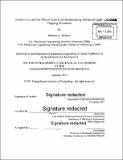| dc.contributor.advisor | Gang Chen. | en_US |
| dc.contributor.author | Branham, Matthew S | en_US |
| dc.contributor.other | Massachusetts Institute of Technology. Department of Mechanical Engineering. | en_US |
| dc.date.accessioned | 2015-07-17T19:51:21Z | |
| dc.date.available | 2015-07-17T19:51:21Z | |
| dc.date.copyright | 2015 | en_US |
| dc.date.issued | 2015 | en_US |
| dc.identifier.uri | http://hdl.handle.net/1721.1/97833 | |
| dc.description | Thesis: Ph. D., Massachusetts Institute of Technology, Department of Mechanical Engineering, 2015. | en_US |
| dc.description | Cataloged from PDF version of thesis. | en_US |
| dc.description | Includes bibliographical references (pages 105-110). | en_US |
| dc.description.abstract | Solar photovoltaics, which convert the energy potential of photons from the sun directly into electrical power, hold immense promise as a cornerstone of a clean energy future. Yet their cost remains greater than that of conventional energy sources in most markets and a barrier to large-scale adoption. Crystalline silicon modules, with a 90% share of the worldwide photovoltaic market, have witnessed a precipitous drop in price over the last decade. But going forward, further evolutionary cost reduction will be difficult given the significant cost of the silicon wafer alone - roughly 35% of the module. Dramatically reducing the thickness of silicon used to make a solar cell from the current 350 [mu]m could rewrite the economics of photovoltaics. For thin-film crystalline silicon solar cells to deliver the anticipated cost benefits of reduced material requirements, it is essential that they also yield power conversion efficiencies comparable to commercial solar cells. A significant hurdle to realizing elevated efficiency in crystalline silicon films thinner than 20 [mu]m is the loss of current resulting from reduced photon absorption. A range of light management structures have been proposed in the literature to address this issue and many have been demonstrated to provide high absorption across the spectral range relevant to crystalline silicon, but their promise has yet to be realized in an active photovoltaic device. The focus of this thesis is the development of an experimental platform and fabrication process to evaluate the effectiveness of theoretically-designed light-trapping structures in functional photovoltaic devices. The experimental effort yielded 10-pm-thick crystalline silicon solar cells with a peak short-circuit current of 34.5 mA cm-² and power conversion efficiency of 15.7%. The record performance for a crystalline silicon photovoltaic of such thinness is enabled by an advanced light-trapping design incorporating a 2D photonic crystal and a rear dielectric/reflector stack. A parallel line of questioning addressed in this thesis is whether periodic wavelength-scale optical structures are superior to periodic or random structures with geometric-optics-scale features. Through the synthesis of experimental and theoretical evidence, the case is constructed that wavelength-scale light-trapping structures are in fact comparable to conventional random pyramid surface structures for broad-spectrum absorption in silicon solar cells as thin as 5 [mu]m. These results have important implications for the design of cost-effective and manufacturable light-trapping structures for ultrathin crystalline silicon solar cells. | en_US |
| dc.description.statementofresponsibility | by Matthew S. Branham. | en_US |
| dc.format.extent | 110 pages | en_US |
| dc.language.iso | eng | en_US |
| dc.publisher | Massachusetts Institute of Technology | en_US |
| dc.rights | M.I.T. theses are protected by copyright. They may be viewed from this source for any purpose, but reproduction or distribution in any format is prohibited without written permission. See provided URL for inquiries about permission. | en_US |
| dc.rights.uri | http://dspace.mit.edu/handle/1721.1/7582 | en_US |
| dc.subject | Mechanical Engineering. | en_US |
| dc.title | Ultrathin crystalline silicon solar cells incorporating advanced light-trapping structures | en_US |
| dc.type | Thesis | en_US |
| dc.description.degree | Ph. D. | en_US |
| dc.contributor.department | Massachusetts Institute of Technology. Department of Mechanical Engineering | |
| dc.identifier.oclc | 913390314 | en_US |
